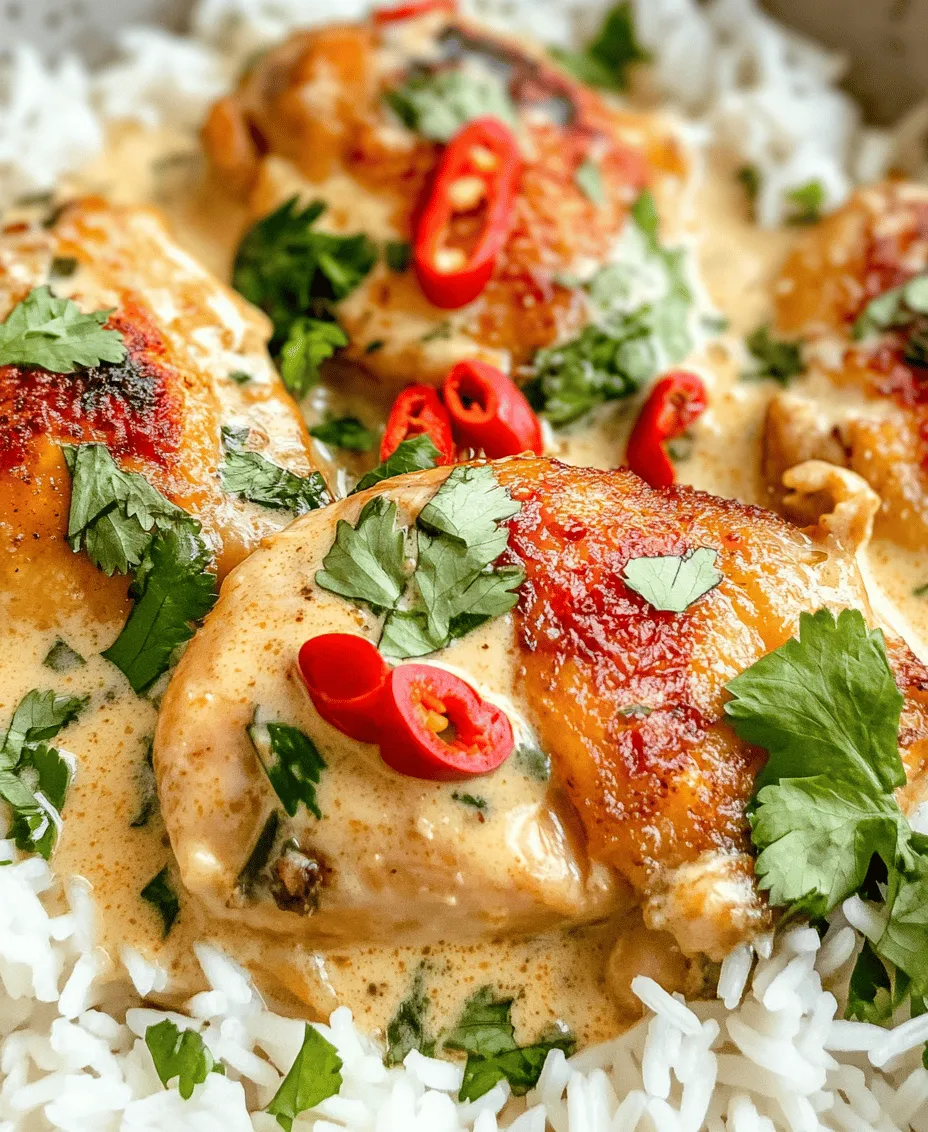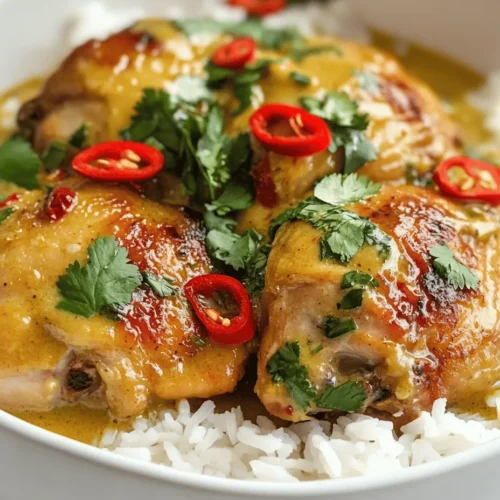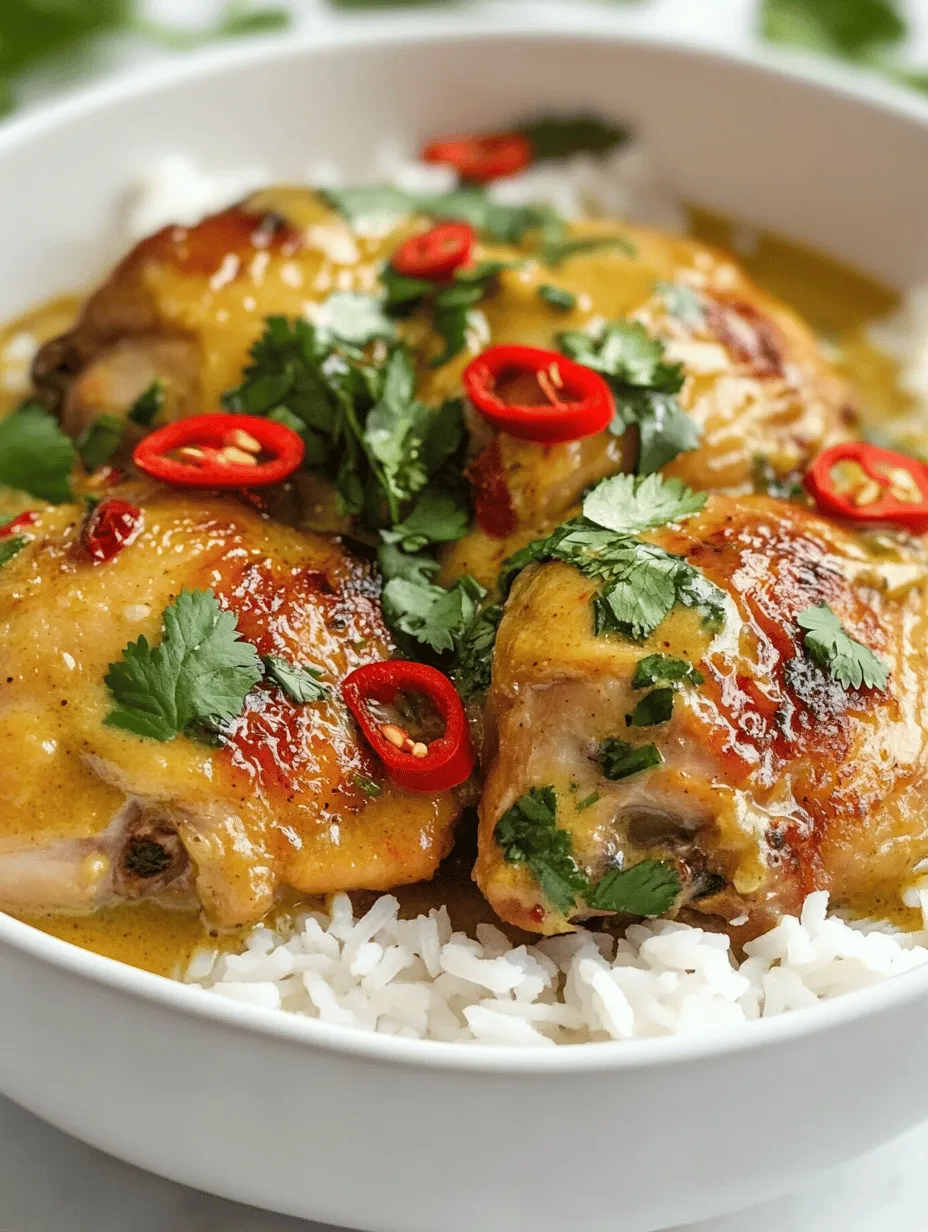Introduction
Brazilian cuisine is a vibrant tapestry woven from the rich cultural influences of indigenous peoples, African traditions, and European settlers. This culinary melting pot is known for its bold flavors, colorful presentations, and an array of ingredients that reflect the diverse ecosystems of the country. Among the many beloved dishes that hail from Brazil, Spicy Brazilian Coconut Chicken stands out as a delightful combination of heat and creaminess, making it a must-try for anyone looking to explore this dynamic cuisine.
Spicy Brazilian Coconut Chicken is not just a dish; it’s an experience that brings together the warmth of spices and the smoothness of coconut milk to create a meal that tantalizes the taste buds. The use of fresh, high-quality ingredients and traditional cooking techniques is crucial in bringing this dish to life. As you prepare this recipe, you’ll find that the depth of flavor comes not only from the spices but also from the love and care put into each step of the cooking process.
Understanding the Flavors of Brazil
To fully appreciate Spicy Brazilian Coconut Chicken, it’s important to understand the key flavor components that define Brazilian cooking. This cuisine boasts a diversity of ingredients that vary from region to region, but certain staples are universally recognized for their role in creating the bold Brazilian flavors we know and love.
Key Ingredients in Brazilian Cooking
1. Coconut Milk: One of the standout ingredients in many Brazilian dishes is coconut milk. This creamy liquid is derived from the flesh of mature coconuts and is a cornerstone in tropical cooking. In Spicy Brazilian Coconut Chicken, coconut milk not only adds a luxurious creaminess but also balances the heat from the spices, creating a perfect harmony of flavors.
2. Fresh Chili Peppers: Brazil is home to a variety of chili peppers that can range from sweet to fiery. Incorporating fresh chili peppers into dishes allows for a customizable spice level, which is essential for catering to different palates. This flexibility is a hallmark of Brazilian cooking, where each cook can make a dish their own.
3. Aromatics: Onions and garlic are foundational aromatics in Brazilian cuisine. They form the base of many dishes and contribute layers of flavor that enhance the overall profile of the meal. When sautéed, they release essential oils that create a fragrant backdrop for the other ingredients.
4. Signature Spices: Brazilian cooking often features spices like paprika, cumin, and turmeric. These spices not only add color but also bring their unique flavors to the dish. Paprika provides a smoky undertone, cumin offers a warm earthiness, and turmeric imparts a golden hue along with its distinct, slightly bitter taste.
5. Lime Juice: The addition of lime juice is crucial in Brazilian dishes, as it introduces acidity and brightness. This component helps to cut through the richness of the coconut milk and balances the heat from the spices, making each bite refreshing.
6. Fresh Cilantro: Often used as a garnish, fresh cilantro elevates the dish by adding a burst of herbal freshness. In Brazilian culture, cilantro is more than just a garnish; it symbolizes the vibrant and lively spirit of Brazilian cooking.
Ingredient Breakdown
Now that we have a foundational understanding of Brazilian culinary elements, let’s dive deeper into the specific ingredients used in our Spicy Brazilian Coconut Chicken recipe.
Chicken Thighs
For this recipe, bone-in and skin-on chicken thighs are preferred. This choice is deliberate: the bone adds richness and depth of flavor during cooking, while the skin crisps up beautifully, providing both texture and moisture. Chicken thighs are also more forgiving than chicken breasts, remaining tender and juicy even if slightly overcooked.
Coconut Milk
Coconut milk is not just a creamy addition; it’s a nutritional powerhouse. Rich in healthy fats, it provides energy and essential nutrients. Its naturally sweet flavor complements the spices beautifully, allowing the dish to maintain a balance between heat and sweetness. When selecting coconut milk, look for a high-quality, full-fat version to ensure the best flavor and consistency.
Fresh Chili Peppers
Selecting the right chili peppers is key to mastering the spice level of this dish. Brazilian cuisine celebrates a variety of chilies, such as malagueta and dedo de moça. These peppers offer distinct heat profiles and can be adjusted based on personal preference. For those who enjoy a milder dish, removing the seeds and membranes can help tone down the heat without sacrificing flavor.
Aromatics: Onion and Garlic
The combination of onion and garlic is a classic base in many dishes, including our Spicy Brazilian Coconut Chicken. Onions add sweetness and depth, while garlic brings a pungent, aromatic quality that enhances the overall flavor profile. Sautéing these aromatics until they are translucent allows them to release their flavors fully, creating a fragrant base for the chicken.
Spices: Paprika, Cumin, and Turmeric
Each spice in this recipe has a unique role. Paprika adds a smoky flavor and deep red color, cumin contributes warmth and earthiness, and turmeric not only enhances the visual appeal with its bright hue but also provides anti-inflammatory benefits. Together, these spices create a complex flavor profile that is characteristic of Brazilian cooking.
Lime Juice
Lime juice is an essential component that brings brightness to the dish. It cuts through the richness of the coconut milk and balances the heat from the spices. A squeeze of fresh lime at the end of cooking can elevate the dish and enhance the overall flavor experience.
Fresh Cilantro
Cilantro is the finishing touch that ties the dish together. Its bright, herbaceous notes add freshness and contrast the rich flavors of the coconut milk and spices. Additionally, cilantro is a popular herb in Brazilian cooking, often used to garnish various dishes, making it a culturally significant ingredient.
Preparation Steps for Spicy Brazilian Coconut Chicken
With a solid understanding of the ingredients, we can now move on to the preparation steps that will guide you in creating Spicy Brazilian Coconut Chicken. The first major step is marinating the chicken, which is a crucial process in developing flavor.
Step 1: Marinating the Chicken
1. Gather Your Ingredients: Begin by assembling your chicken thighs, fresh chili peppers, onion, garlic, lime juice, and spices. Having everything ready will streamline the marinating process.
2. Prepare the Marinade: In a mixing bowl, combine coconut milk, minced garlic, chopped onion, lime juice, paprika, cumin, turmeric, and a pinch of salt. This mixture will serve as both a marinade and a cooking sauce, ensuring the chicken absorbs all the wonderful flavors.
3. Chop the Chili Peppers: Depending on your heat preference, finely chop the fresh chili peppers. If you prefer a milder dish, consider removing the seeds and membranes before chopping. Add the chopped peppers to the marinade for an extra kick.
4. Marinate the Chicken: Place the chicken thighs in a large resealable plastic bag or a non-reactive dish. Pour the marinade over the chicken, ensuring that each piece is well-coated. Seal the bag or cover the dish with plastic wrap and place it in the refrigerator to marinate for at least 1 hour, or ideally, overnight. This process will allow the flavors to penetrate the meat, resulting in a more flavorful dish.
5. Preheat the Cooking Surface: When you’re ready to cook, preheat a large skillet or Dutch oven over medium-high heat. A heavy-bottomed pan is ideal for even cooking and browning.
As you complete these initial steps, you set the stage for a delicious cooking experience that will culminate in a flavorful and comforting meal. The marinating process not only enhances the chicken’s flavor but also tenderizes it, ensuring a juicy result that will impress your family and friends.
In the next section, we will explore the cooking process to bring this Spicy Brazilian Coconut Chicken to life, continuing our journey through this flavorful Brazilian dish.

Importance of Marination in Flavor Development
Marination plays a crucial role in enhancing the flavors of Spicy Brazilian Coconut Chicken. By allowing the chicken to soak in a mixture of spices, citrus, and aromatics, you create a deeper flavor profile that penetrates the meat. The key ingredients in the marinade—such as lime juice, garlic, and a blend of spices—work together to tenderize the chicken while infusing it with a zesty kick. For optimal results, marinate the chicken for at least 30 minutes, though an overnight soak is ideal. This extended time allows the flavors to develop fully, resulting in a chicken dish that is not only delicious but also aromatic and vibrant.
Techniques for Searing Chicken to Achieve the Perfect Golden Crust
Searing chicken is an essential step in preparing Spicy Brazilian Coconut Chicken that enhances both texture and flavor. To achieve that perfect golden crust, start by ensuring that your skillet is hot before adding the chicken. Use a heavy-bottomed skillet or cast iron pan, as these retain heat well.
1. Preheat the Pan: Heat your skillet over medium-high heat until it’s hot but not smoking.
2. Add Oil: Pour in a high smoke-point oil, such as canola or coconut oil, which complements the dish.
3. Pat the Chicken Dry: Before adding the marinated chicken to the pan, pat it dry with paper towels. This helps to create a better sear by reducing moisture.
4. Avoid Crowding: Place the chicken pieces in a single layer, ensuring they are not overcrowded. This allows for even cooking and prevents steaming.
5. Don’t Move It: Once the chicken is in the pan, avoid moving it around. Let it sear for 5-7 minutes on each side, or until a golden-brown crust forms. This caramelization process adds depth of flavor.
Tips for Sautéing Aromatics to Release Their Full Flavor Potential
Sautéing aromatics, such as onions, garlic, and ginger, is a vital step in building the flavor base for your Spicy Brazilian Coconut Chicken. Here are some tips to ensure you maximize their potential:
1. Heat Control: Begin with medium heat to prevent burning the aromatics. You want them to soften and become fragrant rather than charred.
2. Order of Addition: Start with onions, as they take longer to cook. Once they are translucent, add garlic and ginger. These should be added later because they cook faster and can become bitter if overcooked.
3. Use Fresh Ingredients: Fresh garlic and ginger will provide a stronger flavor compared to dried versions. Always opt for fresh where possible to enhance your dish.
4. Deglaze the Pan: After sautéing, consider deglazing the pan with a splash of chicken stock or coconut milk. This will lift the browned bits off the bottom, adding even more flavor to your dish.
The Process of Adding Coconut Milk and Achieving the Right Consistency
Once your chicken is seared and the aromatics are sautéed, it’s time to add coconut milk, which is the star ingredient in this recipe. When adding coconut milk, follow these steps to ensure the right consistency:
1. Incorporate Gradually: Pour the coconut milk slowly into the pan while stirring to combine it with the sautéed aromatics. This helps prevent lumps and ensures a smooth sauce.
2. Balance the Flavor: Taste the coconut milk mixture after adding it. You can adjust the seasoning with salt, pepper, or additional spices based on your preference.
3. Simmer for Thickness: Allow the mixture to simmer gently. If you want a thicker sauce, let it reduce on low heat, stirring occasionally. If it becomes too thick, add a bit of chicken stock or water to achieve your desired consistency.
Guidelines for Simmering Chicken to Ensure Tenderness and Juiciness
To ensure your chicken remains tender and juicy, it’s crucial to simmer it correctly. Here’s how to do it:
1. Cover and Cook: After adding the chicken back into the pot with the coconut milk, cover it with a lid. This helps retain moisture and heat, allowing the chicken to cook evenly.
2. Maintain a Gentle Simmer: Lower the heat to medium-low to maintain a gentle simmer. A rapid boil can lead to tough chicken.
3. Cooking Time: Simmer the chicken for about 20-30 minutes, depending on the size of the pieces. You’ll know it’s done when the chicken reaches an internal temperature of 165°F (75°C) and is no longer pink in the center.
4. Resting Period: After cooking, let the chicken rest for a few minutes before serving. This allows the juices to redistribute throughout the meat, ensuring each bite is succulent.
Serving Suggestions
Presentation Ideas for Serving Spicy Brazilian Coconut Chicken
Presentation can elevate any dish, and Spicy Brazilian Coconut Chicken is no exception. Here are some ideas for serving:
– Serve in a Shallow Bowl: Ladle the chicken and sauce into a shallow bowl and garnish with fresh cilantro, lime wedges, and sliced red chili for a pop of color.
– Layered Approach: Create a beautiful plating by layering coconut chicken over a bed of fluffy white rice or quinoa, allowing the sauce to cascade over the grains.
– Use Coconut Shells: For a fun presentation, serve the dish in hollowed-out coconut shells, which will add to the tropical appeal.
Suggestions for Sides that Complement the Dish
To round out your meal, consider serving Spicy Brazilian Coconut Chicken with these complementary sides:
– Steamed Jasmine Rice: The light and fragrant nature of jasmine rice pairs perfectly with the rich coconut sauce.
– Black Beans: A traditional staple in Brazilian cuisine, seasoned black beans provide a hearty contrast to the chicken.
– Fried Plantains: Sweet and crispy plantains add a delightful sweetness and texture to the meal, balancing the spiciness of the chicken.
– Green Salad: A simple salad with mixed greens, avocado, and a citrus vinaigrette can provide a fresh and zesty contrast.
Cultural Context of Serving Coconut Chicken in Brazil
In Brazil, coconut chicken is a beloved dish often enjoyed during family gatherings and festive occasions. The combination of coconut and spices reflects the country’s rich culinary heritage, influenced by Indigenous, African, and Portuguese cultures. Serving coconut chicken embodies the warmth of Brazilian hospitality, where meals are occasions for connection and celebration. It’s not uncommon to find this dish served at beach barbecues, showcasing Brazil’s vibrant flavors and its connection to tropical ingredients.
Nutritional Information
Breakdown of the Nutritional Content of the Dish
Spicy Brazilian Coconut Chicken is not only delicious but also offers a range of nutritional benefits. Here’s a breakdown of the key components:
– Calories: Approximately 350-450 calories per serving, depending on portion size and added ingredients.
– Protein: Rich in protein from the chicken, providing about 25-30 grams per serving.
– Fats: Healthy fats from coconut milk, averaging around 20 grams, with a mix of saturated and unsaturated fats.
– Carbohydrates: Minimal carbs, mainly from any sides served, with around 30 grams if paired with rice or beans.
Health Benefits of Key Ingredients
– Chicken: A lean source of protein, essential for muscle repair and growth, and contains vital nutrients like B vitamins and selenium.
– Coconut Milk: Contains medium-chain triglycerides (MCTs), which are believed to be more easily used for energy compared to other fats. It also provides a good dose of vitamins C and E and other antioxidants.
– Spices: Ingredients like garlic and chili peppers are not only flavorful but also packed with antioxidants and anti-inflammatory properties.
Tips for Making the Dish More Nutritious or Accommodating Dietary Restrictions
1. Lean Cuts: Opt for skinless chicken breasts or thighs to reduce fat content.
2. Reduce Coconut Milk: For a lighter version, you can substitute part of the coconut milk with low-fat milk or broth.
3. Add Vegetables: Incorporate vegetables like bell peppers, spinach, or carrots into the dish to increase fiber and nutrient content.
4. Gluten-Free Options: This dish is naturally gluten-free, making it suitable for those with gluten sensitivities.
Variations and Adaptations
Ideas for Modifying the Recipe to Suit Different Taste Preferences
Spicy Brazilian Coconut Chicken is versatile, allowing for various adaptations to cater to different palates:
– Adjust the Spice Level: If you prefer a milder dish, reduce the amount of chili peppers or omit them altogether.
– Sweet and Spicy Twist: Add a tablespoon of brown sugar or honey to balance out the heat with a touch of sweetness.
Vegetarian or Vegan Alternatives to the Chicken and Coconut Milk
For those looking for vegetarian or vegan options, consider these substitutions:
– Tofu or Tempeh: Both are excellent protein sources that can absorb the flavors of the marinade and sauce. Use firm tofu or tempeh, marinate, and then cook as you would the chicken.
– Coconut Cream: For a richer, creamier texture, you can use coconut cream instead of coconut milk, making the dish even more indulgent.
Suggestions for Adding Vegetables or Other Proteins
– Vegetable Medley: Add vegetables such as zucchini, bell peppers, or snap peas to the simmering chicken for added nutrition and color.
– Seafood Variation: Substitute chicken for shrimp or fish, adjusting the cooking time accordingly, as seafood cooks much faster.
Conclusion
Spicy Brazilian Coconut Chicken is a delightful dish that captures the essence of Brazilian cuisine with its unique blend of flavors and cultural significance. The marriage of spicy seasonings with creamy coconut milk creates a comforting yet invigorating experience that is sure to please. As you cook and share this dish with loved ones, you’ll not only enjoy the flavors but also celebrate the vibrant culinary traditions of Brazil.
Exploring Brazilian cuisine opens the door to a world of diverse ingredients and preparation methods. Whether you’re a seasoned cook or just starting, this dish invites you to experiment and find joy in the kitchen. So gather your ingredients, embrace the flavors, and enjoy the process of cooking and sharing this delicious meal with friends and family.



